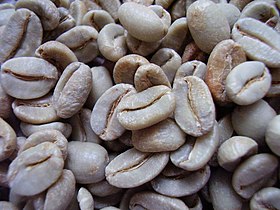Green coffee
Green coffee is obtained from the fruits of the coffee bush through processing (mostly in the country of harvest).
When processing coffee beans , the skin, the pulp (the so-called pulp), the mucus on the parchment skin, the parchment skin and - as far as possible - the silver skin are removed. This can be achieved on the dry route - then one speaks of unwashed coffee - as well as on the wet route - one speaks of washed coffee. Beans processed dry, including the pulp, are dried in the sun and only then removed from the pulp. As a result, the beans take on the sweetness and taste of the pulp. This makes the coffees comparatively sweet and fruity. With the washed preparation, the pulp is removed after harvest and the coffee beans without pulp are dried for about 4–10 days. This results in a very clear and clean taste in the coffee, and at the same time also more acidic coffee. In addition, there are mixed forms, such as the honey process or so-called semi-washed processes, in which the fruit is mechanically freed from part of the pulp, but the so-called mucilage ("fruit slime") remains around the beans during drying. This allows the coffee to develop a clarity, but at the same time has a pleasant sweetness, which often gives very balanced coffees. Which type of processing is used often depends on the climatic conditions in the growing countries and on traditions. More and more experiments are being carried out with the preparation of coffees for both Arabica and Robusta (Canephora) coffee beans in order to further develop the variety of taste of coffee beans and to increase quality and yields.
In a final treatment, any remaining impurities are removed and the beans - with high-quality coffees by hand - sorted, that is, sorted according to size and quality. This results in the market-ready green coffee, which is then roasted (often in the consumer country) .
Trade unit and modes of transport
Green coffee is still traded today - on the Bremen Stock Exchange - in the unit of a sack weighing 60 kg. While 300 sacks, i.e. 18 tons of coffee, used to be placed in a 20-foot sea container, 21.6 tons of green coffee can be poured into a container of the same size equipped with a synthetic fiber liner . Seagoing ship - inland waterway ship from Bremerhaven to Bremen - heavy truck (from 2003 special permit with conditions total weight 65 t on 7-axle truck trailer train instead of 44 t for combined transport) within Bremen - and possibly a train to Berlin is the transport chain to Jacobs. In the containers, drying bags and cardboard supplements help to avoid condensation on the beans. The liner, also called "inlet", has to be supported by a tensioned rope net or cross bars in the door opening, which is open when filling.
In Brazil the sack is 60 kg, but in Central America it is 69 kg - derived from 150 pounds.
Web links
- General information
- Green coffee from cultivation to preparation
- Article green coffee in KaffeeWiki - German-language wiki about espresso, coffee and machines
Individual evidence
- ↑ Types of preparation of coffee. In: Roast Rebels. Retrieved March 22, 2019 .
- ↑ Claudia Behrend: Maritime Logistics: A clever train: The coffee train of the Diedrich Meyer between the Bremen Holzhafen and the roastery Jacobs in Bremen-Hemelingen wfb-bremen.de, Logistics Pilot, print August 2017, online September 6, 2017, accessed 23 February 2019. - The article states both the net content of a (bulk) container and - probably wrongly - its gross mass of 21.6 t.
- ↑ Powertex® Bulk Container Liner Installation StudioAntoDesign.powertex.com, youtube.com, October 16, 2014, accessed February 23, 2019. - Video (1:51).
- ↑ Coffee sacks - the measure of the beans docklands-coffee.de, accessed February 23, 2019.
